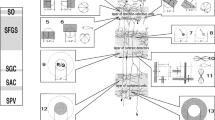Abstract
Steady state patterns of currents flowing extracellularly in the receptor layer of the frog retina are used to work out an electrical model of vertebrate rods. The model can be thought of as a linear network consisting of resitances and current sources. The model predicts the axial spread of currents along the outside of the receptors. In addition, it predicts membrane voltages in light and darkness. If the dark-adapted receptors are assumed to have a uniform membrane with a specific resistance of 500 Ω·cm2, a single rod gives rise to an extracellular dark current of about 200 pa.
Similar content being viewed by others
References
Baumann, Ch.: Die absolute Schwelle der isolierten Froschnetzhaut. Pflügers Arch. ges. Physiol. 280, 81–88 (1964)
Ehrhardt, W., Jagger, W., Baumann, Ch.: Scotopic photocurrents in the receptor layer of the frog retina. Pflügers Arch. ges. Physiol. 362, R 46 (1976)
Ernst, W., Jagger, W.S.: Photoresponses from the retinal receptor layer of the frog. J. Physiol. 238, 58–60 (1974)
Falk, G., Fatt, P.: An analysis of light-induced admittance changes in rod outer segments. J. Physiol. 229, 185–220 (1973)
Hagins, W.A., Penn, R.D., Yoshikami, S.: Dark current and photocurrent in retinal rods. Biophys. J. 10, 380–412 (1970)
Jagger, W.S.: Extracellular currents in the retinal receptor layer of the frog (Rana esculenta). J. Physiol. 241, 58–59 P (1974)
Korenbrot, J.I., Cone, R.A.: Dark ionic flux and the effects of light in isolated rod outer segments. J. Gen. Physiol. 60, 20–45 (1972)
Küpfmüller, K.: Einführung in die theoretische Elektrotechnik. 10. Aufl., pp. 424–425, Berlin-Heidelberg-New York:Springer 1973
Stämpfli, R.: Bau und Funktion isolierter markhaltiger Nervenfasern. Ergebn. Physiol. 47, 70–165 (1952)
Toyoda, J., Nosaki, H., Tomita, T.: Light-induced resistance changes in single photoreceptors of Necturus and Gekko. Vision Res. 9, 453–463 (1969)
Toyoda, J., Hashimoto, H., Anno, H., Tomita, T.: The rod response in the frog as studied by intracellular recording. Vision Res. 10, 1093–1100 (1970)
Werblin, F.S.: Regenerative hyperpolarization in rods. J. Physiol. 244, 53–80 (1975)
Young, R.W.: Passage of newly formed protein through the connecting cilium of retinal rods in the frog. J. Ultrastruct. Res. 23, 462–473 (1968)
Zuckerman, R.: Ionic analysis of photoreceptor membrane currents. J. Physiol. 235, 333–354 (1973)
Author information
Authors and Affiliations
Rights and permissions
About this article
Cite this article
Ehrhardt, W., Baumann, C. The spatial distribution of currents in the receptor layer of the frog retina. Biol. Cybernetics 25, 155–162 (1977). https://doi.org/10.1007/BF00365212
Received:
Issue Date:
DOI: https://doi.org/10.1007/BF00365212




